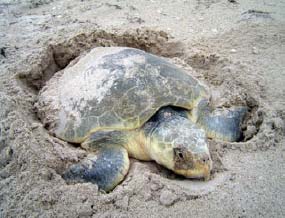 |
| NPS photo | | Kemp's ridley sea turtles lay around 100 eggs per nest. |
 |
The Kemp’s ridley sea turtle, Lepidochelys kempii, is the smallest of the five species of sea turtles found in the Gulf of Mexico (others include loggerhead, green, hawksbill, and leatherback). It has an average length of 23 to 27.5 inches (58.5 to 70 cm) and average weight of 100 pounds (45 kg). The Kemp's ridley is the only sea turtle with an almost circular upper shell. The young are dark gray in color but change as they mature. Adults are olive green above and yellow below.
Kemp’s ridley turtles reach maturity at 10-15 years of age. On average, females lay 2.5 clutches per nesting season and nest every 2 years, although there are variations between individuals. Most nesting occurs during daylight hours between April 1 and July. They often nest in groups called arribadas, typically occurring on windy days.
Their diet consists mostly of crabs (Shaver, 1991). Nests contain 80-120 eggs with an average of around 100. The group of eggs laid by one mother at one time is referred to as a "clutch".
The Kemp’s ridley's range is chiefly in the Gulf of Mexico, but immature turtles, probably carried by the currents, often appear along the Atlantic coast as far north as New England and Nova Scotia. Adults occur primarily in the Gulf of Mexico. The primary nesting beach for Kemp’s ridley is at and near Rancho Nuevo, Tamaulipas, Mexico.
To help insure their survival in the event of a disaster affecting the Kemp's ridley primary nesting beach, in 1978 the governments of the USA and Mexico joined together in an attempt to re-establish a nesting colony at Padre Island National Seashore. Kemp’s were known to nest on the island sporadically.
During each summer from 1978 to 1988, approximately 2,000 Kemp’s ridley eggs were transported from Rancho Nuevo to the National Seashore. Here they were incubated and the hatchlings were temporarily released into the water. They were then collected and transported to a facility in Galveston, Texas. The young turtles were raised until they were about a year old. This effort was called the "head-start" program. It was hoped that this program would enhance their survival rate by releasing young turtles that were too big for most predators to eat as opposed to the natural process in which only one out of every 100 to 1,000 hatchlings likely survives to maturity. Hopes were also high that because a Kemp’s ridley typically returns to the beach of its birth for its own nesting, that the turtles would return to Padre Island National Seashore as adults. This is where the hatchlings were first released and potentially "imprinted" with a memory of the island. Of the 22,507 eggs received, 17,358 (77.1%) hatched and 13,454 turtles were released into the Gulf of Mexico after 9 to 11 months of head-starting.
Today, the National Park Service locates, studies, and protects nesting Kemp’s ridley turtles and their eggs at the National Seashore. The National Park Service maintains the records of the sea turtle nests found in Texas and collaborates with and provides technical assistance to other entities leading nest detection programs elsewhere in Texas. Eggs found on North Padre Island and northward along the Texas coast are transported to the National Seashore's incubation facility for protected care. Left unprotected on the beach the eggs and hatchlings can fall victim to a variety of human-related and natural threats. When patrollers locate a track site where a nesting female emerged on the beach, but biologist are unsuccessful at finding the nest after hours of searching, a trained Kemp's ridley nest detector dog is often brought to the site.
From 1979 to 1996, seventeen Kemp’s ridley nests were documented along the Texas coast, most of which were found at the National Seashore. Two of the nests found in 1996 were from turtles that had "living tags" indicating that they had been incubated at the National Seashore and head-started. Nesting by Kemp's ridleys has increased on the Texas coast since and is doubling every 1-3 years. Most nests are from turtles in the wild stock.
The table below shows how the nesting seasons have progressed on the Texas coast since 1996 (Shaver, 2005, unpublished data). Note that these nests found at Padre Island National Seashore normally make up about 60% of the nests found along the Texas coast.
|
Year
|
No. of Nests
|
No. of Eggs
|
Hatchlings Released
|
Number of Headstart Nests
|
|
1996
|
6
|
590
|
369
|
2
|
|
1997
|
9
|
968
|
893
|
0
|
|
1998
|
13
|
1,270
|
800
|
4
|
|
1999
|
16
|
1,681
|
1,364
|
7
|
|
2000
|
12
|
1,160
|
1,000
|
1
|
|
2001
|
8
|
837
|
584
|
2
|
|
2002
|
38
|
3,771
|
2,536
|
6
|
|
2003
|
19
|
1,718
|
1,426
|
4
|
|
2004
|
42
|
3,928
|
3,298
|
7
|
|
2005
|
50
|
4,700
|
3,402
|
9
|
|
2006
|
102
|
9,717
|
7,475
|
9
|
| 2007 |
128 |
12,555 |
10,596 |
8 |
|
Total
|
443
|
42,895
|
33,743
|
59
|
|






